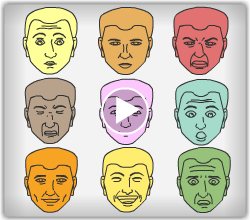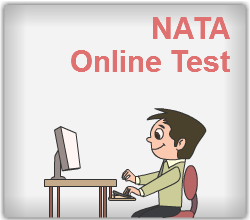NATA 2024 SYLLABUS
Nata assesses the candidate's aptitude for study of Architecture by evaluating various aspects:
- Cognitive skills
- Visual perception and aesthetic sensitivity tests
- Logical reasoning and critical thinking ability
- Knowlege & skills the candidate has aquired over the years, particularly those relevant to architecture.
Due to the situations arising as a consequence of the pandemic, Nata Exam for the year 2020, 2021, 2022 & 2023 were conducted in online mode only.
But for the year 2024, the old standard pattern ie. "Online + Offline"has been resumed.
And this article, will be a major help providing you details about Nata exam syllabus 2024.
Before filling Nata exam application form 2024, candidates are advised to check Nata exam eligibility criteria.
Also, going through Nata Entrance Details, helps the candidates to understand the scheme of exam.
Table of Contents
Syllabus of Nata
NATA New Syllabus 2024
The aptitude test of Nata will comprise of two parts:
Part A - Drawing & Composition Test
This is an offline test & will be held for a duration of 90 minutes.
This test will have 3 questions carrying 80 marks in total.
Part B - MCQ - Computer Based Online Test
This online test will be held for a duration of 90 minutes.
This test will have a total of 45 questions carrying 120 marks in total.
| Nata 2024 | Nata Preparation | Nata Important Dates |
Nata Test Pattern
| Part A | Part B |
| Pencil & Paper Based Test | Computer Based Test |
| Drawing & Composition Test | MCQ Test |
| Offline Test | Online Test |
| Carry 3 Questions | Carry 45 Questions |
| Duration: 90 Min | Duration: 90 Min |
| Medium: English & Hindi | Medium: English & Hindi |
| Total Marks: 80 | Total Marks: 120 |
|
A1 - 1 Ques X 25 Marks A2 - 1 Ques X 25 Marks A3 - 1 Ques X 30 Marks |
B1-30 Ques X 2 Marks = 60 Marks B2-15 Ques X 4 Marks = 60 Marks |
|
Part A-Drawing & Composition Test A1 - 1 Ques - Composition & Color A2 - 1Ques - Sketching & Composition A3 - 1 Ques - 3D Composition |
Part B-Computer Based Online Test B1 - MCQs B2 - MCQs |
The total marks for Part A & Part B is 200 marks.
- Download Nata 2024 Brochure
Nata Subjects
The aptitude of the candidate will be assessed using some or all of the following:
Nata Drawing Test Syllabus
PART - A Drawing and Composition Test
This is one and half hour (90 minutes) - 80 marks test where candidate has to attempt three questions .
The content of the Part A Test is as follows:
| TOPICS | DETAILS |
| A1 - Composition & Color - 25 Marks | Creating suitable compositions for various situations and coloring them appropriately. Re-arranging various shapes in visually appealing manner and coloring it suitably. |
| A2 - Sketching and Composition (Black and White) - 25 Marks | Ability to draw, visualize, depict a situation, involving buildings/its components, people, environment, products with an understanding of scale, proportions, textures, shades and shadow etc. |
| A3 - 3D Composition - 30 Marks | Creating interesting 3D composition for the given situation using the provided kit. |
Articles that may help you prepare for the above Topics:
Articles related to " Composition & Color " topic:
| Drawings for Nata Exam: Are you Making these Mistakes? |
| NATA Preparation: How to Attempt 2D Compositions? |
Articles related to "Sketching and Composition" topic:
| Drawing Questions of Nata: Common Mistakes | Nata Entrance Drawings: Common Mistakes |
| Is Birds Eye View Important for Nata Exams? | Nata Exam Drawings: Common Mistakes & Corrections |
Articles related to "3D Composition" topic:
NATA Coaching: How to make 3D Sculpture?
Articles related to Nata Drawing Test:
Have you Solved this Previous Year Question Paper of Nata?More to Explore...

NATA Study Material
NATA Books: Available in Full, Mini, Combo & Test Series Pack. Doorstep delivery across India.
Details
NATA eBooks
Study at Home with Nata eBooks! Instant Download. Saves Time. Learn at your own pace!
Details

NATA Free Online Test
Free NATA Online Test based on Nata Exam Pattern - Includes Timer, Detailed Results & Answer Key.
DetailsNata Online Test Syllabus
Part B Computer Based Online Test
This is one and half hour (90 minutes), 120 marks test where candidate has to appear for online test.
It shall have two type of questions viz., B1 - 30 questions of 2 marks and B2 - 15 questions of 4 marks from the following topics:
| TOPICS | DETAILS |
| Visual Reasoning | Ability to understand and reconstruct 2D and 3D composition, knowledge about its composition and technical concepts. |
| Logical Derivation | Ability to decode a situation, composition, context and generate meaning. Understanding the minute information hidden in a particular situation and drawing conclusions. |
| G.K., Architecture & Design | General awareness of architecture and design, current issues, recent episodes etc., Knowledge about important buildings, historical progression, innovation in materials and construction technology. |
| Language Interpretation | Ability to correctly and logically generate meaning of words, sentences, understanding about English grammar. |
| Design Sensitivity | Ability to observe, record and analyze people, space, product, environment. Critical thinking, reasoning and ability to identify the subtle communications. |
| Design Thinking | Ability to understand semantics, metaphors, problem identification and definition, analysis of a given situation. |
| Numerical Ability | Basic Mathematics and its association with creative thinking. To unfold a space with use of geometry. |
Articles that may help you prepare for the above Topics:
Articles related to "G.K., Architecture & Design" topic:
| Nata Architecture Awareness Questions | How to Prepare for Nata Aptitude Test? |
| NATA Online Test: What to Prepare? | Nata Aptitude Test Questions |
| Aptitude Preparation for Nata | Nata Aptitude Preparation |
Article related to "Numerical Ability" topic:
Articles related to Nata Online Test:
Nata 2024 Syllabus Frequently Asked Questions (FAQS)
Ques 1. What type of questions are asked in Nata exam?
Ans 1. For Computer Based MCQ Test: Questions related to Logical Reasoning, Architectural GK, Architectural Awareness, Material & Construction Study, Understanding of basic Mathematics & English Grammar, Ability to visualize in 2D & 3D, Design Thinking & Design Sensitivity.
For Drawing Test: Questions on Architectural Drawings, Compositions, Buildings, People, Ability to Visualize & Draw in 2Dimension & 3Dimension.
Ques 2. Is Physics and Chemistry included in Nata?
Ans 2. Though questions related to Physics & Chemistry are not asked in Nata exam, candidates should study (compulsory) both the subjects in 10+2 qualifying exam. This qualifying criteria does not apply to Diploma Students, whose qualifying exam is 10+3 Diploma Exam.
Ques 3. What are the subjects in Nata exam?
Ans 3. The subjects from which questions are asked in Nata exam are aptitude based. These subjects are not generally taught in school. Candidates with good aptitude for the field of Architecture are likely to perform well in these subjects. For others, prior preparation is required.
Ques 4. What to study for Nata exam?
Ans 4. For Nata Self Study at home, we at Mosaic have prepared a study pack containing 15 Books & 48 videos (Bonus). VIEW: NATA Full Study material
Ques 5. What is the Syllabus for Nata exam?
Ans 5. Council of Architecture has provided Nata Aspirants the Syllabus for Nata 2024 through Nata Brochure. You can also find the detailed Nata Syllabus here
About the Author: Anu Handa is an Interior Designer, DIY Artist, Co-Founder and Educator at Mosaic Institute of Design. She has been the lead blogpost writer at www.mosaicdesigns.in since 2009. Her educational background in Interior Design, Urban Planning and the English Language has given her a broad base to cover a range of topics in her articles. Anu has spent 15+ years training Design & B.Arch Aspirants for entrance exams.
Passionate about Design Education, she’s briefly worked with Annamalai University as a paper setter for Design Exams. Likes to write about Design, Architecture and related fields, on online platforms like Quora. Aims at challenging the conventional & age old teaching methodology.




































